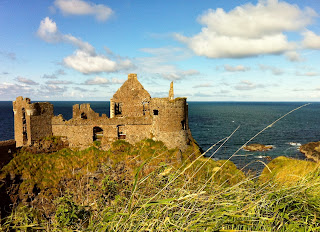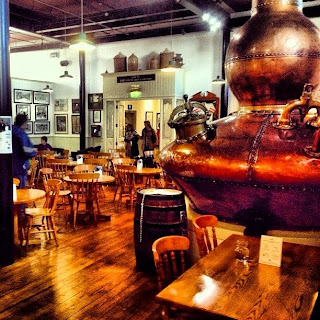
We arrived at the Stena Line Cairnryan Ferry Port before dawn. Rather than paying to bring our rental car to Northern Ireland, we took advantage of the free parking and boarded on foot. The savings went toward a guided tour that would provide some narrative of the region as well as getting us to the castle expediently.
We would, after all, be covering about 75% of "One of the World's Great Road Journeys," The Causeway Coastal Route, in one day. According to the map our guide gave us, it should be a five day itinerary.
The ferry was modern and comfortable, although I didn't stretch out like others on the sofas to sleep. I drank endless cappuccino from a self service coffee station for 2 pounds 50 while reading the Mickey Mantle autobiography I'd bought at the Seal Beach library for a dime.
 |
| Northern Ireland Countryside |
We visited the Seal Beach library the same day when the depth of Julie's Ancestry.com addiction was revealed, and I must admit to having seen some ancestors named Mantle in the 19th century of my family tree, possibly influencing my book choice, having pondered whether I might be related to number 7, but I digress.

We arrived on time but were disappointed that no guide with our name printed neatly on a card awaited. Julie kept rechecking her papers, saying he'd be there any minute. After a half hour, we finally called, and it turned out he was at the wrong ferry station. Another twenty minutes later, as he promised on that call, the van pulled up in front, and we were on our way. It was a good reminder that the best laid plans should often be followed up with a phone call upon arrival.
 |
| Canal in Northern Ireland |
Our guide, Alistair, half owner of City and Causeway Tours, was friendly and loquacious as we sped northward out of Belfast along scenic highways. Alistair definitely had his own agenda, to convince us that stories of danger in Northern Ireland were overblown. Tourists were very welcome and extremely safe, he repeated a dozen times. He revealed his dislike of "sensationalist" news outlets like CNN that almost destroyed his little business after 9/11 with their "exaggerations." All was delivered with a pleasing Irish accent and frequent smile.
 |
| Alister points out sites to Julie and Amy |
He used an iPad to show his photos, including pictures of the region at other times of year, such as the season when Ulex (Irish gorse) blooms with bright yellow flowers to carpet hillsides. Julie and I had seen gorse in Dunedin, New Zealand, where homesick Scottish settlers had transplanted the wildflowers before considering that they might not be able to control their exponential growth outside their natural environment.
 |
| Morning on the Northern Ireland Coastline |
While some flowers weren't yet in bloom, our day was beautiful in every other way, with perfect bright sunny skies to illuminate the many colors of green for which the Emerald Isle is justifiably famous.
Before long, our guide's warmth and obvious love for his homeland made us forget how upset we had been about him going to the wrong ferry line and subsequently being late.
 |
| Fuschias in Northern Ireland |
Alistair said he was a teetotaler, only enjoying a couple of Irish whiskeys on holidays, and we were happy he was stone-cold sober when he took his van off the highways to race down a scenic one lane road in order to avoid being stuck behind the tour buses.
I have no doubt we were going much faster than the recommended speed, but that probably meant we met fewer tourists going the opposite way.
Each time we met a car, we came almost to a stop while they passed in the slightly wider turns, where driver side mirrors still nearly brushed against each other. Apparently locals primarily go the same direction we were, because he called each of the opposing drivers "tourists."
 |
| Coastline Next to Dunluce Castle |
Alistair made a few quick stops for photo ops, but we goaded him on to be sure to have enough time at Dunluce Castle, which was the reason for this excursion. We were supposed to walk across the Carrick-A-Rede Rope Bridge, but concerned about time and with no one particularly interested in doing it, we soon were back in the van and moving on.
On we journeyed to Dunluce Castle, and it was well worth the trip. Beautiful, majestic ruins sit at what would be a panoramic viewing spot with or without the castle.
 |
| Panoramic View of Dunluce Castle |
After walking around, taking photos for a while, we headed into the Wee Cottage, which Alistair had touted as having the best scones anywhere.
 |
| Dunluce Castle "Interior" |
We ordered scones, coffee and sandwiches, asking for the scones to be delivered before the sandwiches. Unlike the cherry-berry scone we enjoyed at Holyroodhouse, which was after all a rather typical looking scone, these scones were exceptional: split in half and loaded with a large dollop of heavy whipped cream and berries. It's lucky we only ordered two for our family to split. Eating them before our sandwiches seemed rather silly, since they were obviously dessert, but we enjoyed them.
After lunch, we headed back out to explore the castle grounds more. A placard told a brief story of MacQuillan ownership, and I've done a bit of research to try to verify what I can, but with further research, the McQuillan history seems somewhat murky.
 |
| Trail to Dunluce Castle |
We know that in the era before the MacQuillans (this is the spelling used at Dunluce Castle, but McQuillan and McQuillen are used elsewhere) took ownership of the castle, Irish lords invited Robert the Bruce to help liberate Ireland from Norman rule, just as he had liberated Scotland from the English.
We know the MacQuillan name first made an appearance in Dunluce Castle's region, Ulster, in the early 1300s, when a mercenary named Seonagg MacUibhilin (Sean MacQuillan) was recorded as having killed Aedh O'Connor.
Beyond that, it becomes conjecture. I would guess that Seonagg, with probably some brothers at his side, earned honor fighting valiantly under the leadership of Edward Bruce, brother of Robert the Bruce, and that the MacQuillans came from Scotland with Edward Bruce.
 |
| Another view of Dunluce Castle |
Mac, Mc or Miec means "son of." At this tribal and nearly illiterate time in the history of Scotland and Ireland, there wasn't much need to know anything within a clan beyond first name and father's name, unless someone was a duke, which still referred to the old Roman connotation of military leader of a region. No such MacQullen duchy seemed to exist in Scotland or Ireland before Dunluce, so this was probably the first generation of renown. There was a king of Scotland with a similar name in the early 1200s, Alexandair MacUilliam (son of Uilliam "The Lion"), but he only had one son, King Alexandair MacAlaxandair, so this would seem to be a different family, with the name shifting at the succeeding generation.
 |
| Dunluce Castle Distant Profile |
 |
| Giant's Causeway, the Mythical Way Back to Scotland |
The Irish lords of Ulster, O'Donnell and O'Neill, agreed to let Edward Bruce become King of Ireland in exchange for Scottish military assistance. He was crowned in 1316. Robert the Bruce soon came to join his brother, and they plundered Ireland, replaying an old historic theme. In 1318, Robert returned to Scotland with his booty, and eventually Edward died, leaving Ireland to the Irish, along with some mercenaries who decided to keep on fighting under new leadership.
 |
| Dunluce photo taken from fence |
It could be that Sean MacQuillan and family were from Ireland, and it also could be, as some have conjectured, that the real Norman family name was de Mandeville, and it was changed to MacQuillan to sound more Irish and hold onto their reign.
 |
| Giant's Causeway |
A MacQuillan was likely a commander for de Mandeville who earned the castle region as a reward for loyal military service, as well as the promise to give de Mandeville a share of the plunder gathered by MacQuillan's Route.
The Route was basically a band of roaming mercenaries who collected tribute from anyone they crossed. Perhaps the MacQuillans took Dunluce Castle by force as spoils of victory. In any case, the name MacQuillan became established in the region as a powerful family commanding a large region, but about 200 years later, after being soundly defeated by Sorley Boy MacDonnell at the Battle of Aura, the MacQuillans disappeared from history.
 |
| Bushmills Distillery Tasting Room |
Well, not entirely. McQuillans and McQuillens have popped up around Ireland, Scotland and, of course, North America, including Lester McQuillen and a couple of earlier generations born in Kentucky.
It's funny how things naturally tie together if you look for the serendipitous connections.
Our next stop was the Bushmills Distillery Tour, where we learned how Irish whiskey is made, including Bushmills' use of old Kentucky bourbon barrels.
 |
| Old Bushmills Distillery |
Irish distilleries buy the used Kentucky bourbon barrels and use them to age their whiskey. While I'm not a big hard liquor imbiber, I've always thought bourbon tastes much better than Irish whiskey. After the tour, they gave us samples of 12 Year Old Bushmills, and it still tasted disgusting to me.
 |
| Wes, Jay and Amy at uncrowded spot at Giant's Causeway |
Our last big stop was Giant's Causeway, which was swarming with tourists. Maybe swarming is a bit too strong, but this was obviously a big draw to tourists from around the world, with the Led Zeppelin tie-in probably contributing to the interest.
My son Jay shared the myth of the Giant's Causeway, which he had read earlier. An Irish giant named Finn challenged a Scottish giant to a fight. Because no boat would be large enough to carry a giant across the sea, Finn built a causeway (bridge) so the Scottish giant would have no excuse to avoid the fight.
 |
| Giant's Causeway with Scotland on the distant horizon |
However, when Finn saw his nemesis crossing the bridge, he realized the Scot was bigger and more powerful than he had imagined. He asked his wife for advice, and she dressed Finn like a baby. Seeing the huge "baby," the Scottish giant imagined the great Finn must be even bigger and more ferocious, so he ran back across the sea, destroying the causeway as he went to avoid being followed by Finn. The odd stones left on the shore of Northern Ireland are all that remain of the Giant's Causeway.
 |
| Crowds at the Giant's Causeway |
With Scotland's coast visible a short distance away, it is easy to understand how such a fanciful legend might have originated to answer questioning children.
We made a couple of other quick stops on the way back to the ferry, including a tree lined street used in filming Game of Thrones, and the Titanic Quarter. We didn't have time to drink a Guinness at a Belfast pub, much less see what kind of reaction we'd get if we ordered an Irish Car Bomb (Guinness with Baily's Irish Cream dropped in).
Without question, there is much more to explore in Northern Ireland, but it was time to hop the ferry back to Scotland.
By the end of the trip, Julie was talking about sending Alistair a thank you gift, having been touched by his gift of a souvenir pin to commemorate the visit to Dunluce Castle as well as by his devoted care in sharing a glimpse of his beloved homeland.

